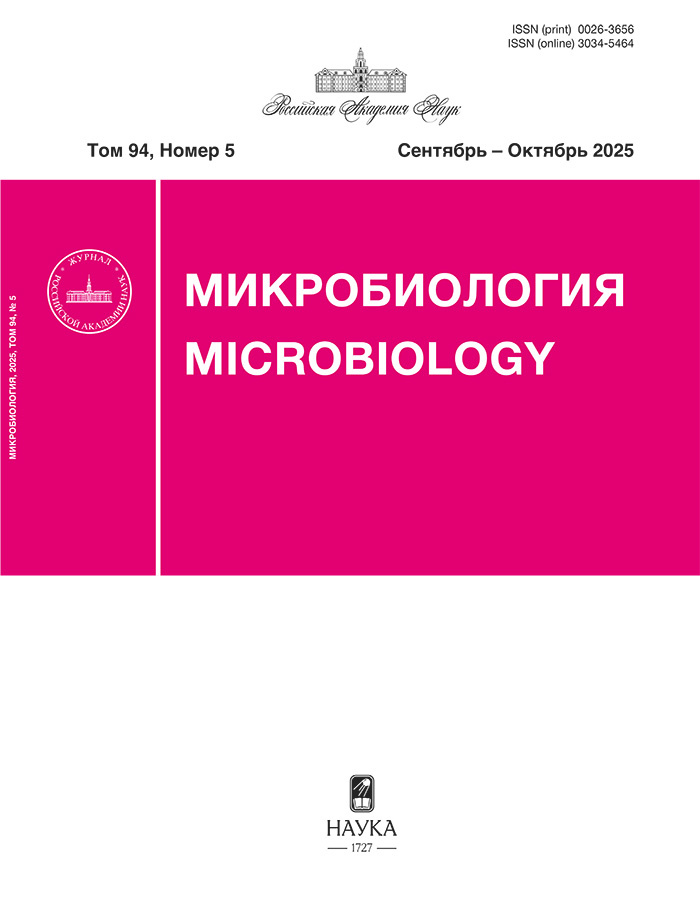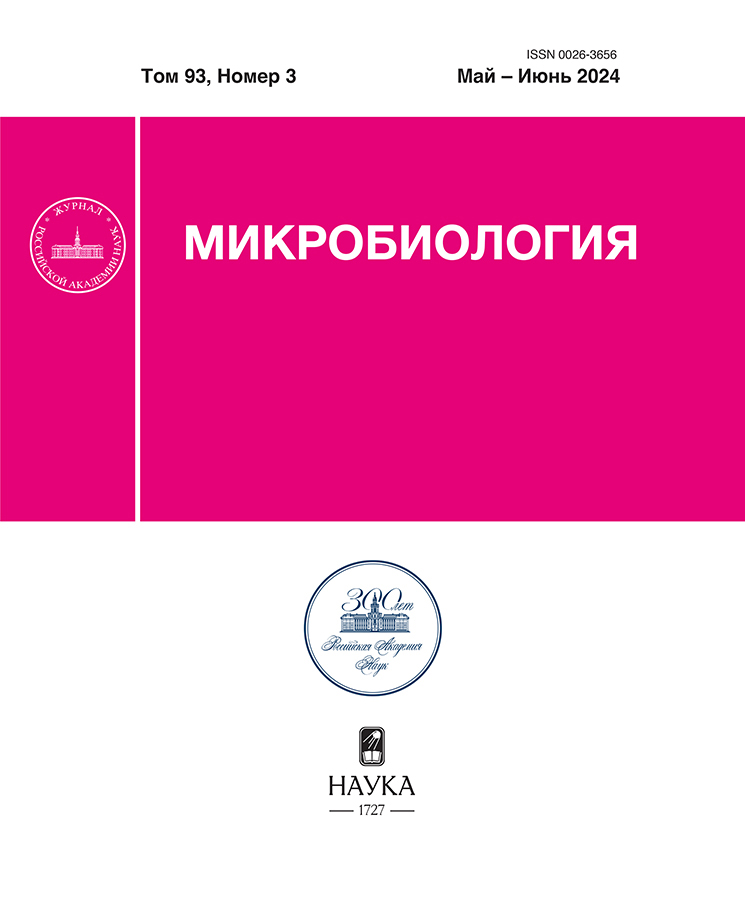Грибы арктических морей
- Авторы: Кочкина Г.А.1, Пинчук И.П.1, Иванушкина Н.Е.1, Автух А.Н.1, Пименов Н.В.2
-
Учреждения:
- Институт биохимии и физиологии микроорганизмов им. Г.К. Скрябина, ФИЦ Пущинский научный центр биологических исследований РАН
- Институт микробиологии им. С.Н. Виноградского, ФИЦ биотехнологии РАН
- Выпуск: Том 93, № 3 (2024)
- Страницы: 278-289
- Раздел: ЭКСПЕРИМЕНТАЛЬНЫЕ СТАТЬИ
- URL: https://rjdentistry.com/0026-3656/article/view/655113
- DOI: https://doi.org/10.31857/S0026365624030039
- ID: 655113
Цитировать
Полный текст
Аннотация
Изучены численность и разнообразие мицелиальных грибов в донных отложениях морей Северного Ледовитого океана — Гренландского, Баренцева и Карского. Пробы поверхностных донных отложений были отобраны в 84-м (июль‒август 2021 г.) и 86-м (октябрь‒ноябрь 2021 г.) рейсах НИС “Академик Мстислав Келдыш”. Таксономическую принадлежность выделенных грибов определяли с помощью полифазной таксономии. Выделенные грибы были отнесены к 16 родам разных классов аскомицетовых, базидиомицетовых и зигомицетовых грибов. Было определено влияние температуры и разных концентраций NaCl в среде на рост грибов, а также влияние условий культивирования на профиль жирных кислот для штаммов, способных к росту на средах с повышенным осмотическим потенциалом. Показано, что состав жирных кислот изменяется в зависимости от условий солености среды, но ответ на осмостресс у изученных культур из глубоководных донных отложений различается.
Ключевые слова
Полный текст
Об авторах
Г. А. Кочкина
Институт биохимии и физиологии микроорганизмов им. Г.К. Скрябина, ФИЦ Пущинский научный центр биологических исследований РАН
Автор, ответственный за переписку.
Email: gak@dol.ru
Россия, Пущино
И. П. Пинчук
Институт биохимии и физиологии микроорганизмов им. Г.К. Скрябина, ФИЦ Пущинский научный центр биологических исследований РАН
Email: gak@dol.ru
Россия, Пущино
Н. Е. Иванушкина
Институт биохимии и физиологии микроорганизмов им. Г.К. Скрябина, ФИЦ Пущинский научный центр биологических исследований РАН
Email: gak@dol.ru
Россия, Пущино
А. Н. Автух
Институт биохимии и физиологии микроорганизмов им. Г.К. Скрябина, ФИЦ Пущинский научный центр биологических исследований РАН
Email: gak@dol.ru
Россия, Пущино
Н. В. Пименов
Институт микробиологии им. С.Н. Виноградского, ФИЦ биотехнологии РАН
Email: gak@dol.ru
Россия, Москва
Список литературы
- Бубнова Е. Н., Бондаренко С. А., Георгиева М. Л. Первые сведения о грибах арктических морей Сибири // Труды VIII Международной научно-практической конференции “Морские исследования и образование (MARESEDU-2019)”. Т. I (III). Тверь: ООО “ПолиПРЕСС”, 2020. С. 383‒384.
- Бубнова Е. Н., Коновалова О. П. Грибы в донных грунтах Чукотского моря // Биология моря. 2019. Т. 45. № 2. С. 86‒96. https://doi.org/10.1134/S0134347519020025
- Бубнова Е. Н., Никитин Д. А. Грибы в донных грунтах Баренцева и Карского морей // Биология моря. 2017. Т. 43. С. 366‒371.
- Bubnova E. N., Nikitin D. A. Fungi in bottom sediments o the Barents and Kara Seas // Russ. J. Mar. Biol. 2017. V. 43. P. 400‒406.
- Конова И. В., Сергеева Я. Э., Галанина Л. А., Кочкина Г. А., Иванушкина Н. Е., Озерская С. М. Липогенез грибов Geomyces pannorum при воздействии стрессоров // Микробиология. 2009. Т. 78. С. 52‒58.
- Konova I. V., Sergeeva Ya.E., Galanina L. A., Kochkina G. A., Ivanushkina N E., Ozerskaya S. M. Lipid synthesis by Geomyces pannorum under the impact of stress factors // Microbiology (Moscow). 2009. V. 78. P. 42–47.
- Кочкина Г. А., Иванушкина Н. Е., Акимов В. Н., Гиличинский Д. А., Озерская С. М. Галопсихротолерантные грибы рода Geomyces из криопэгов и морских отложений Арктики // Микробиология. 2007. Т. 76. С. 39‒47.
- Kochkina G. A., Ivanushkina N. E., Akimov V. N., Gilchinsky D. A., Ozerskaya S. M. Halopsychrotolerant fungi of the genus Geomyces from cryopegs and marine sediments of the Arctic // Microbiology (Moscow). 2007. V. 76. P. 39–47.
- Кочкина Г. А., Озерская С. М., Иванушкина Н. Е., Чигинева Н. И., Василенко О. В., Спирина Е. В., Гиличинский Д. А. Разнообразие грибов деятельного слоя Антарктиды // Микробиология. 214. Т. 83. С. 236‒244. https://doi.org/10.7868/s002636561402013x
- Kochkina G. A., Ozerskaya S. M., Ivanushkina N. E., Chigineva N. I., Vasilenko O. V., Spirina E. V., Gilichinskii D. A. Fungal diversity in the Antarctic active layer // Microbiology (Moscow). 2014. V. 83. P. 94‒101.
- Мамаева Е. В., Галачьянц Ю. П., Хабудаев К. В., Петрова Д. П., Погодаева Т. В., Ходжер Т. В., Земская Т. И. Метагеномный анализ микробных сообществ донных осадков шельфа Карского моря и Енисейского залива // Микробиология. 2016. Т. 85. С. 187–198.
- Mamaeva E. V., Galach’yants Y.P., Khabudaev K. V., Petrova D. P., Pogodaeva T. V., Khodzher T. B., Zemskaya T. I. Metagenomic analysis of microbial communities of the sediments of the Kara Sea shelf and the Yenisei Bay // Microbiology (Moscow). 2016. V. 85. P. 220–230.
- Озерская С. М., Кочкина Г. А., Иванушкина Н. Е., Князева Е. В., Гиличинский Д. А. Структура комплексов микромицетов в многолетнемерзлых грунтах и криопэгах Арктики // Микробиология. 2008. Т. 77. С. 542‒550.
- Ozerskaya S. M., Kochkina G. A., Ivanushkina N. E., Knyazeva E. V., Gilichinskii D. A. The structure of micromycete complexes in permafrost and cryopegs of the Arctic // Microbiology (Moscow). 2008. Т. 77. P. 482‒489.
- Стахов В. Л., Губин С. В., Максимович С. В., Ребриков Д. А., Савилова А. М., Кочкина Г. А., Озерская С. М., Иванушкина Н. Е., Воробьева Е. А. Микробные сообщества древних семян, извлеченных из многолетнемерзлых плейстоценовых отложений // Микробиология. 2008. Т. 77. С. 396‒403.
- Stakhov V. L., Gubin S. V., Maksimovich S. V., Rebrikov D. V., Savilova A. M., Kochkina G. A., Ozerskaya S. M., Ivanushkina N. E., Vorobyova E. A. Microbial communities of ancient seeds derived from permanently frozen Pleistocene deposits // Microbiology (Moscow). 2008. V. 77. P. 348‒355.
- Хуснуллина А. И., Биланенко Е. Н., Кураков А. В. Микроскопические грибы донных грунтов Белого моря // Сибирский экологический журнал. 2018. Т. 25. С. 584‒598. https://doi.org/10.15372/SEJ20180507
- Khusnullina A. I., Bilanenko E. N., Kurakov A. V. Microscopic fungi of White Sea sediments // Contemp. Probl. Ecol. 2018. V. 11. P. 503‒513.
- Begmatov S., Savvichev A. S., Kadnikov V. V., Beletsky A. V., Rusanov I. I., Klyuvitkin A. A., Novichkova E. A., Mardanov A. V., Pimenov N. V. Microbial communities involved in methane, sulfur, and nitrogen cycling in the sediments of the Barents Sea // Microorganisms. 2021. V. 9. Art. 2362. https://doi.org/10.3390/microorganisms9112362
- Burgaud G., Hué N. T.M., Arzur D., Coton M., Perrier-Cornet J.M., Jebbar M., Barbier G. Effects of hydrostatic pressure on yeasts isolated from deep-sea hydrothermal vents // Res. Microbiol. 2015. V. 166. P. 700‒709. https://doi.org/10.1016/j.resmic.2015.07.005
- Carré L., Zaccai G., Delfosse X., Girard E., Franzetti B. Relevance of earth-bound extremophiles in the search for extraterrestrial life // Astrobiology. 2022. V. 22. P. 322‒367. https://hal.science/hal-03819312
- Cox F., Newsham K. K., Bol R., Dungait J. A.J., Robinson C. Not poles apart: Antarctic soil fungal communities show similarities to those of the distant Arctic // Ecol. Lett. 2016. V. 19. P. 528–536. https://doi.org/10.1111/ele.12587
- de Hoog G. S., Zalar P., van den Ende B. G., Gunde-Cimerman N. Relation of halotolerance to human-pathogenicity in the fungal tree of life: an overview of ecology and evolution under stress // Adaptation to life at high salt concentrations in Archaea / Eds. Gunde-Cimerman N., Oren A., Plemenitas A. Dordrecht: Springer, 2005. P. 371‒397.
- Ding Z., Li L., Che Q., Li D., Gu Q., Zhu T. Richness and bioactivity of culturable soil fungi from the Fildes Peninsula, Antarctica // Extremophiles. 2016. V. 20. P. 425–435. https://doi.org/10.1007/s00792-016-0833-y
- Hagestad O. C., Andersen J. H., Altermark B., Hansen E., Rämä T. Cultivable marine fungi from the Arctic Archipelago of Svalbard and their antibacterial activity // Mycology. 2020. V. 11. P. 230‒242. https://doi.org/10.1080/21501203.2019.1708492
- Hayashi Y., Eguchi H., Toibana T., Mitamura Y., Yaguchi T. Polymicrobial sclerokeratitis caused by Scedosporium apiospermum and Aspergillus cibarius // Cornea. 2014. V. 33. P. 75‒877.
- Ivanushkina N. E., Kochkina G. A., Ozerskaya S. M. Fungi in ancient permafrost sediments of the Arctic and Antarctic regions // Life in Ancient ice / Eds. J. Castello, S. Rogers. Ch. 9. Proc. Prins. Univ. Princeton: Princeton Univ. Press, 2005. P. 127‒139.
- Jin L., Quan C., Hou X., Fan S. Potential pharmacological resources: natural bioactive compounds from marine-derived fungi // Mar. Drugs. 2016. V. 14. Art. 76. https://doi.org/10.3390/md14040076
- Kochkina G. A., Ivanushkina N. E., Lupachev A. V., Starodumova I. P., Vasilenko O. V., Ozerskaya S. M. Diversity of mycelial fungi in natural and human-affected Antarctic soils // Polar Biol. 2019. V. 42. P. 47–64. https://doi.org/10.1007/s00300-018-2398-y
- Kumar S., Stecher G., Li M., Knyaz C., Tamura K. MEGA X: molecular evolutionary genetics analysis across computing platforms // Mol. Biol. Evol. 2018. V. 35. P. 1547‒1549. https://doi.org/10.1093/molbev/msy096
- Leong S. L. L., Lantz H., Pettersson O. V., Frisvad J. C., Thrane U., Heipieper H. J., Dijksterhuis J., Grabherr M., Pettersson M., Tellgren-Roth C., Schnürer J. Genome and physiology of the ascomycete filamentous fungus Xeromyces bisporus, the most xerophilic organism isolated to date // Environ. Microbiol. 2015. V. 17. P. 496‒513.
- Luo M., Zang R., Wang X., Chen Z., Song X., Ju J., Huang H. Natural hydroxamate-containing siderophore acremonpeptides A–D and an aluminum complex of acremonpeptide D from the marine-derived Acremonium persicinum SCSIO 115 // J. Nat. Prod. 2019. V. 82. P. 2594‒2600. https://doi.org/10.1021/acs.jnatprod.9b00545
- Luo Y., Xu W., Luo Zh.-H., Pang K.-L. Diversity and temperature adaptability of cultivable fungi in marine sediments from the Chukchi Sea // Bot. Mar. 2020. V. 63. P. 197‒207. https://doi.org/10.1515/bot-2018–0119
- Margesin R., Miteva V. Diversity and ecology of psychrophilic microorganisms // Res. Microbiol. 2011. V. 162. P. 346‒361. https://doi.org/10.1016/j.resmic.2010.12.004
- Martorell M. M., Ruberto L. A.M., Fernandez P. M., De Figueroa L. I.C., Mac Cormack W. P. Biodiversity and enzymes bioprospection of Antarctic filamentous fungi // Antarct. Sci. 2019. V. 31. P. 3‒12. https://doi.org/10.1017/S0954102018000421
- Namsaraev Z., Kozlova A., Tuzov F., Krylova A., Izotova A., Makarov I., Bezgreshnov A., Melnikova A., Trofimova A., Kuzmin D., Patrushev M., Toshchakov S. Biogeographic analysis suggests two types of planktonic prokaryote communities in the Barents Sea // Biology. 2023. V. 12. Art. 1310. https://doi.org/10.3390/biology12101310
- Ogaki M. B., Pinto O. H.B., Vieira R., Neto A. A., Convey P., Carvalho-Silva M., Rosa C. A., Camara P., Rosa L. H. Fungi present in Antarctic deep-sea sediments assessed using DNA metabarcoding // Microb. Ecol. 2021. V. 82. P. 157‒164. https://doi.org/10.1007/s00248-020-01658-8
- Ozerskaya S., Kochkina G., Ivanushkina N., Gilichinsky D. Fungi in permafrost // Permafrost soils / Ed. R. Margesin (Austria). Berlin‒Heidelberg: Springer Verlag, 2009. P. 85‒95. https://doi.org/10.1007/978-3-540-69371-0_7
- Rapp J. Z., Fernández-Méndez M., Bienhold C., Boetius A. Effects of ice-algal aggregate export on the connectivity of bacterial communities in the Central Arctic Ocean // Front. Microbiol. 2018. V. 9. Art. 1035.
- Rice A. V., Currah R. S. Oidiodendron: A survey of the named species and related anamorphs of Myxotrichum // Stud. Mycol. 2005. V. 53. P. 83‒120. https://doi.org/10.3114/sim.53.1.83
- Ryvarden L., Melo I. Poroid fungi of Europe // Synopsis Fungorum. V. 37. Oslo: Fungiflora A/S, 2017. 431 p.
- Sarkar S., Singh N. A., Rai N. Xerophilic fungi: physiology, genetics and biotechnology // Extremophilic fungi / Eds. Sahay S. Singapore: Springer Nature, 2022. P. 253‒270.
- Savvichev A. S., Rusanov I. I., Kadnikov V. V., Beletsky A. V., Zakcharova E. E., Samylina O. S., Sigalevich P. A., Semiletov I. P., Ravin N. V., Pimenov N. V. Biogeochemical activity of methane-related microbial communities in bottom sediments of cold seeps of the Laptev Sea // Microorganisms. 2023. V. 11. Art. 250. https://doi.org/10.3390/microorganisms11020250
- Sayed A. M., Hassan M. H., Alhadrami H. A., Hassan H. M., Goodfellow M., Rateb M. E. Extreme environments: microbiology leading to specialized metabolites // J. Appl. Microbiol. 2020. V. 128. P. 630‒657. https://doi.org/10.1111/jam.14386
- Shukla S., Shukla H. Ecology, physiology, and diversity of piezophilic fungi // Extremophilic fungi / Singapore: Springer Nature Singapore, 2022. P. 141‒170. https://doi.org/10.1007/978-981-16-4907-3_8
- Simonato F., Campanaro S., Lauro F. M., Vezzi A., D’Angelo M., Vitulo N., Valle G., Bartlett D. H. Piezophilic adaptation: a genomic point of view // J. Biotechnol. 2006. V. 126. P. 11‒25. https://doi.org/10.1016/j.jbiotec.2006.03.038
- Wang Y. N., Meng L. H., Wang B. G. Progress in research on bioactive secondary metabolites from Deep-Sea derived microorganisms // Mar. Drugs. 2020. V. 18. Art. 614. https://doi.org/10.3390/md18120614
- Yurchenko A. N., Girich E. V., Yurchenko E. A. Metabolites of marine sediment-derived fungi: Actual trends of biological activity studies // Mar. Drugs. 2021. V. 19. P. 88. https://doi.org/10.3390/md19020088
Дополнительные файлы












